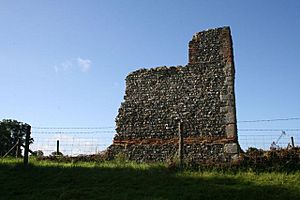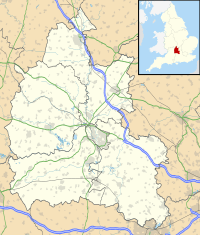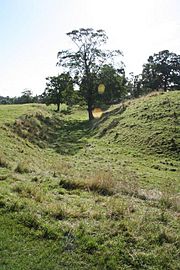Wallingford Castle facts for kids
Quick facts for kids Wallingford Castle |
|
|---|---|
| Oxfordshire, England | |

Ruins of Wallingford Caste
|
|
| Coordinates | 51°36′10″N 1°07′20″W / 51.6029°N 1.1221°W |
| Type | Motte-and-bailey |
| Site information | |
| Condition | Ruined |
| Site history | |
| Battles/wars | The Anarchy, English Civil War |
Wallingford Castle was a very important old castle located in Wallingford, Oxfordshire, England. It was right next to the River Thames. This castle was first built in the 11th century. It started as a "motte-and-bailey" castle, which means it had a big mound (motte) with a tower and a walled area (bailey). It was built inside an old Anglo-Saxon town wall, called a burgh.
Over time, Wallingford Castle grew to be incredibly strong. A historian named Nicholas Brooks said it was "one of the most powerful royal castles" in the 12th and 13th centuries. During a civil war called the Anarchy, it was held by Empress Matilda. The castle faced many attacks but was never captured.
For the next 200 years, it became a fancy home for kings, queens, and their families. But Henry VIII stopped using it as a royal residence, and the castle started to fall apart. It was made strong again during the English Civil War. However, after it was captured by Parliament's army, it was purposely destroyed. This act is called "slighting".
Today, only parts of the castle walls and the large earth mounds remain. These ruins are now open for everyone to visit.
Contents
The Castle's Story: A Look Back
Building a Stronghold: The 11th Century
Wallingford was an important town long ago. It had its own money-making place (mint) and was protected by an Anglo-Saxon town wall, or burgh. This was because it was a key spot to cross the River Thames. When William the Conqueror invaded England in 1066, the town's leader, Wigod of Wallingford, supported him. William even stayed with Wigod.
After his invasion, King William wanted to control the Thames Valley. So, he built three main castles. Two were royal castles: Windsor and Wallingford. The third was Oxford, which later became a royal castle too.
Wallingford Castle was probably built by Robert D'Oyly between 1067 and 1071. Robert married Wigod's daughter and got much of his land. The first castle was made of wood. It was built in the north-east part of the town, using the old Anglo-Saxon walls for protection. The big mound, or motte, was near the river, watching over the river crossing. Building it meant tearing down some important Anglo-Saxon houses.
Today, the motte is about 60 meters (197 feet) wide and 13 meters (43 feet) high. Robert also set up a group of 16 priests inside the castle, called St Nicholas College.
Challenges and Changes: The 12th Century

Wallingford Castle was passed down from Robert to his son-in-law, Miles Crispin, and then to Brien FitzCount. Brien was a strong supporter of King Henry I. He likely made the castle even stronger with stone in the 1130s. He built a very powerful fort. It had a shell keep (a stone wall on top of the motte) and a curtain wall around the main castle area (bailey). Historians like Nicholas Brooks called it "one of the most powerful royal castles" of its time.
After King Henry I died, England faced a difficult time. Two people, Stephen of England and Empress Matilda, both wanted to be the ruler. This period is known as the Anarchy, a civil war. Brien FitzCount decided to support Empress Matilda in 1139. Wallingford Castle became Matilda's most eastern stronghold. It was either her closest base to London or the first place King Stephen's army would attack.
King Stephen attacked the castle in 1139. He planned to surround it because its walls were too strong to attack directly. Brien had stored a lot of food and supplies. People at the time thought the castle could last for years under a siege. So, Stephen changed his plan. He built two smaller castles nearby to block Wallingford. Then he moved his army west. The next year, one of these blocking castles was destroyed.
The civil war became a long fight. Castles like Wallingford were very important. They helped both sides control the Thames Valley. After King Stephen captured Oxford in 1141, Empress Matilda escaped to Wallingford. This made the castle even more important.
Around this time, Brien set up a prison inside the castle called Cloere Brien. It was known for being a tough place. Important people, like William Martel, King Stephen's chief helper, were held there. People in Wallingford town could hear the cries from the prison. There wasn't enough room in the castle for all of Brien's soldiers, so they took over houses in the town.
Between 1145 and 1146, Stephen tried again to take Wallingford. He couldn't capture it, even after building a strong blocking castle across the river at Crowmarsh Gifford. He also built castles to the west. In 1152, he returned with a bigger army. He rebuilt the blocking castle at Crowmarsh Gifford and built another near Wallingford bridge. He planned to starve the castle's defenders out. Brien and his allies tried to break the blockade but failed.
By 1153, the castle's defenders were running out of food. One of Brien's allies made a deal with Stephen to leave the castle. Then, Henry, Empress Matilda's son and the future King Henry II, arrived. He brought his army to help the castle and began attacking Stephen's blocking castles. King Stephen marched back from Oxford, and the two armies met outside Wallingford Castle.
This meeting led to a peace agreement called the Treaty of Wallingford. This treaty eventually ended the civil war and made Henry the next king after Stephen died in 1153. Brien, who had no children, decided to become a monk. He gave Wallingford Castle to Henry in 1153.
Later in the 12th century, the castle became linked to King John. He was given the town by King Richard I in 1189. John took the castle during his own rebellion in 1191. Even though he had to give it back, he got it again when he became king in 1199. King John used Wallingford Castle a lot during the First Barons' War (1215-1216). He made its defenses stronger and had a large group of soldiers protect it.
Royal Residence and Prison: The 13th–15th Centuries
Under King Henry III, Richard, the first Earl of Cornwall, was given the castle in 1231. He made it his main home. Richard lived in great style and spent a lot of money on the castle. He built a new hall and added many luxurious features.
Richard became King of the Romans in 1251, which meant he stopped using the castle as much. But the castle got involved in another civil war, the Second Barons' War, in the 1260s. Simon de Montfort captured the castle after winning a battle. He used it to hold the royal family for a short time before moving them to Kenilworth Castle. After the war, King Henry III got the castle back. It continued to be a fancy home for the Earls of Cornwall for the rest of the century.
King Edward II gave Wallingford Castle first to his friend, Piers Gaveston, and then to his young wife, Isabella of France. A lot of money was still spent on the castle. Edward also used it as a royal jail for his enemies. When Edward was overthrown in 1326, Isabella used the castle as an early base for her invasion of England. Her son, King Edward III, later gave the castle to the Duke of Cornwall, a title used by the king's sons.
The castle continued to be used as a county jail. Many people complained because so many prisoners managed to escape from it. It became harder to pay for the castle's upkeep from local money in the late 14th century. More money from the king was needed to keep it in good shape. Still, in 1399, when King Richard II was removed from power, the castle was very strong. It was a "formidable obstacle" to Richard's enemies and could even host the royal government when it first fled from London.
Wallingford Castle didn't play a big role in the Wars of the Roses. After Henry VIII used it for the last time in 1518, it seems to have stopped being a royal home.
Decline and Destruction: The 16th–19th Centuries

The castle started to fall apart in the 1500s. It was no longer part of the Duchy of Cornwall. Under Queen Mary, parts of the castle were taken apart. Materials like lead were used for Windsor Castle. In 1540, a historian named John Leland wrote that the castle was "nowe sore yn ruine, and for the most part defaced" (meaning mostly destroyed). However, the jail inside the castle was still used, even though prisoners kept escaping.
From 1600 onwards, different nobles owned the castle. It returned to the crown under King Charles I, who gave it to Queen Henrietta Maria. But by then, the castle was mostly valuable for its surrounding land and fishing spots.
The English Civil War began in the 1640s between King Charles I's supporters and Parliament. With the king in Oxford and Parliament in London, the Thames Valley became an important war zone again. Wallingford was a Royalist town. Soldiers were placed there in 1642 to stop Parliament's army from reaching Oxford. Colonel Thomas Blagge became governor. In 1643, the king told him to make the castle strong again and inspected it later that year.
By 1644, nearby towns like Abingdon and Reading had fallen to Parliament. Parliament's forces unsuccessfully attacked Wallingford town and castle in 1645. General Thomas Fairfax then surrounded Wallingford Castle in 1646. After 16 weeks, and after Oxford fell to Parliament, the castle finally gave up in July 1646. The defenders were given good terms.
However, the risk of more fighting continued. So, in 1652, Parliament decided to "slight" the castle. This meant damaging it so much that it couldn't be used for military purposes again. It was still a very strong fortress and a threat if another uprising happened. The castle was almost completely torn down. But a brick building there was still used as a prison until the 1700s. A large house was built in the castle's main area (bailey) in 1700. A fancy "gothic" mansion was built on the same spot in 1837.
Wallingford Castle Today
The mansion, which became too expensive to keep, was torn down in 1972. This allowed Wallingford Castle to be protected as a scheduled monument and a Grade I listed building. The castle grounds are now open to the public. You can see the remains of St Nicholas College, two parts of the castle wall, and the big motte hill.
From 2002 to 2010, archaeologists from Leicester University dug at the site. They wanted to learn more about how the Anglo-Saxon town of Wallingford and its burgh changed into the Norman castle. In 2015 and 2016, another project looked at the castle's motte. Their findings confirmed that the mounds were indeed built by the Normans.
The castle grounds, known as Wallingford Castle Meadows, are looked after by a group called Earth Trust. They manage the land for the South Oxfordshire District Council.




